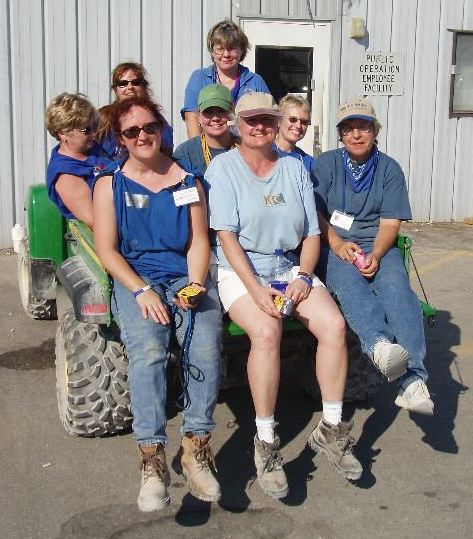
The "crew"
|
The heat and humidity were very draining. The coordinator was very considerate of the workers and checked to make sure we were drinking enough water.
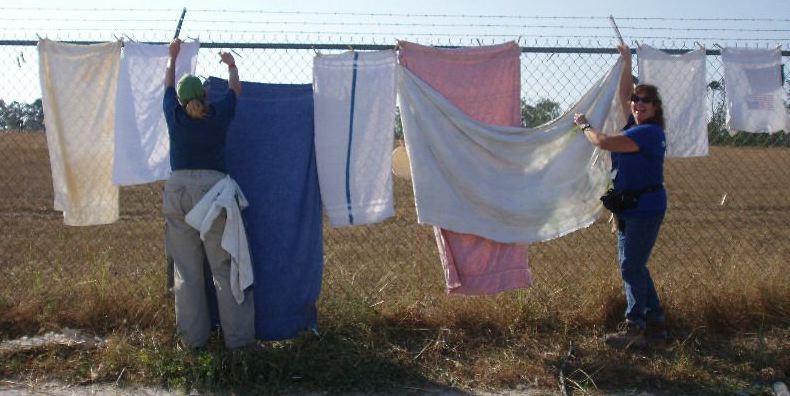
This is how we dried the dogs' towels for their crates, after washing them.
|
After the cleaning and walking, we began set up for the next day, which involved making the bleach solution used for cleaning, refilling the water jugs that were used for the dogs' dishes, replacing the paper towels, emptying the dirty water containers and trash cans, and general clean-up in the building.
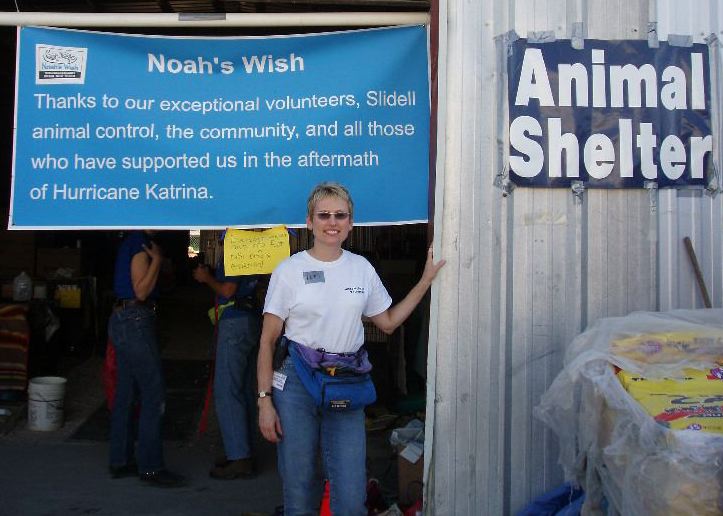
Lori at the shelter entrance
|
After returning with a dog, it was the walker's responsibility to complete the paperwork on the dog. The date, time, what was done, initials, and a record of peeing & pooping was noted. This was really important as it tracked who was not eating or going to the bathroom.
If the walker noticed a problem with the dog, she was to note it and tie an orange tag to the crate as a marker for the vet techs. In more serious cases we took the dogs to vet right away.
|
This picture of Cindy (R) & me (L) was taken in the large pole building that housed most of the dogs and all of the cats. The large yellow flexible pipes in the background blew the cool aire into the building (as Cindy explained). |
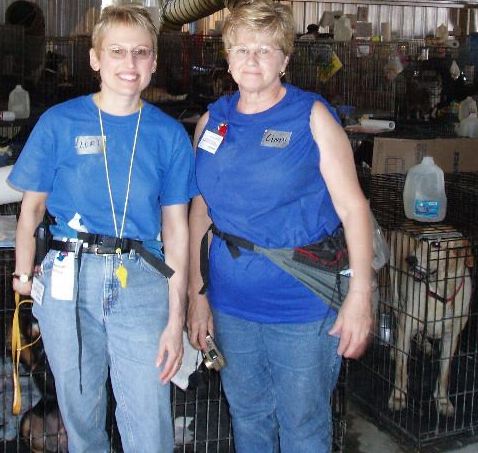
|
Supplies for the shelter seemed plentiful and as specific foods got low they were replaced quickly. Each dog had a Kong or some other type of toy.
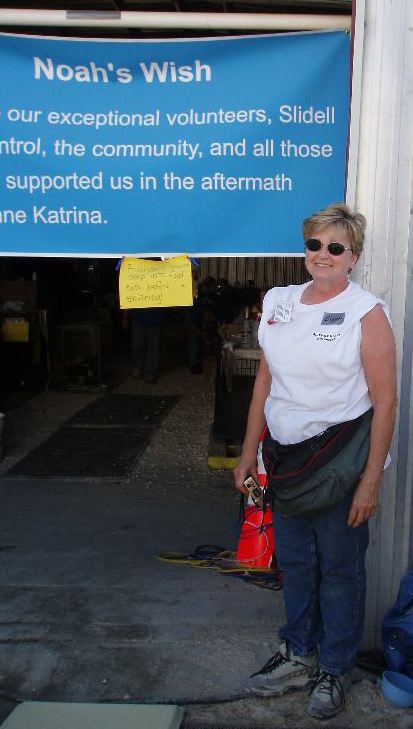
Cindy at the shelter entrance
|
Kim left in the middle of the week and we had another volunteer step up as inside coordinator. We began to form a team and preferred working with the same dogs daily. Occasionally we had up to five walkers and we were able to really get through the dogs quickly.
In the morning, the dogs were desperate to get out, but more desperate to get back inside for breakfast. One day a dog slipped his lead outside - we used whistles to signal a loose dog - when a whistle blew, everyone stopped to help. Anyway, this dog was outside when he slipped his lead, but he took off for the building, ran down the aisle and right into his crate for breakfast. A similar thing happened with another dog. They seem to accept their crates as home. In some cases being feed regularly and receiving loving attention was an improvement for them. There was a sad beagle who had been used as a bait dog for training fighting dogs. This was the sweetest guy whose head was covered with scars. He was still being treated for his wounds.
The next day, two trained coorindinators arrived. These ladies gave new meaning to the hustle. They worked right along side of us as their goal was to get the dogs out three times a day.
We met other volunteers from all over the country and everyone had the same goal: to help the dogs. Many of the volunteers took surrendered animals home with them. There were some homecomings, but it seemed that for every dog that left another was surrendered. Many people came as often as possible to walk their dogs and spend time with them. Seeing a six-year-old lab being surrendered was a heartbreaker - [his people] had no place to live and couldnąt keep him. When they turned around and left, he struggled on the lead to go with them and then just stood and looked at them go.
At breakfast we would meet a group of volunteers from Zaneville, Ohio; as a town, they have adopted Slidell. They come down in groups and have been cleaning up the cemeteries. They are camping, and are so enthusiastic about helping the town.
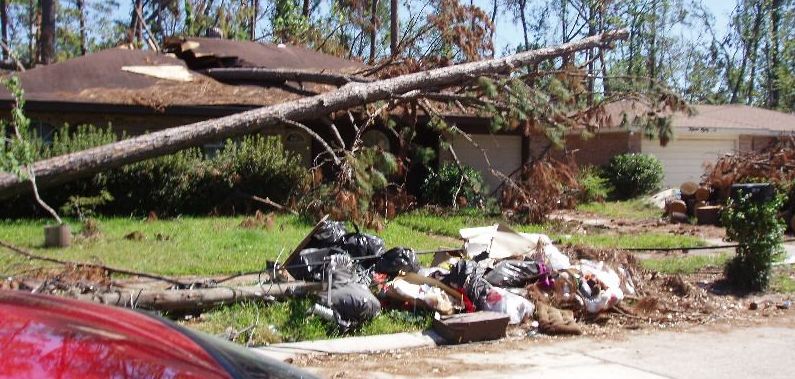
Here is just one of the thousands of homes destroyed by Katrina,
|
The local people we met are so grateful for the help and support. We took a drive around town and witnessed some of the devastation. It was incredible. The mountains of debris, the homes pushed off their foundations, boats turned upside down, vehicles ruined, businesses closed. It seemed like half the town was destroyed.
One of the walkers on our team came every afternoon to help. Her antique business was destroyed with no insurance on the contents, her home was flooded when trees crashed through the roof causing the water heater to flood the house, but she said it gave her structure to come and walk the dogs. She felt that the animals needed her help.
The stories are endless and the experience life-changing, which sounds so dramatic since we got to come home to our nice safe homes and our well-cared-for Airedales. We made sure to check all the crates for any Airedale that might be there. One day we wore our Airedale shirts instead of the required blue shirts; they proved to be a great conversation starter and of course found a former Airedale owner.
We are concerned about the shelter having enough workers, as we only had about the half the usual number on Saturday night, which was our last shift. Hopefully more came in on Sunday.
In summary, it was the hardest work we have ever done, both emotionally and physically (imagine crawling into about 100 wire crates two times a day to clean them, or walking that many dogs twice a day). One puppy, Sadie, regularly pooped in her crate, dumped her water in it, and made poop soup. She would then chase anyone who walked by her crate requiring her crate to be carried outside to be scrubbed as she was having a bath.
We have been the filthiest we have ever been - it was common to look at your arm, hand, or clothing and notice brown stains and think could be dirt, dog food or poop, and then go to lunch. We laughed as well as cried many times during the week.

CONTINUE WITH
IN THE EYE OF THE STORM:
KATRINA "A-TEAM" TRIP HERE
